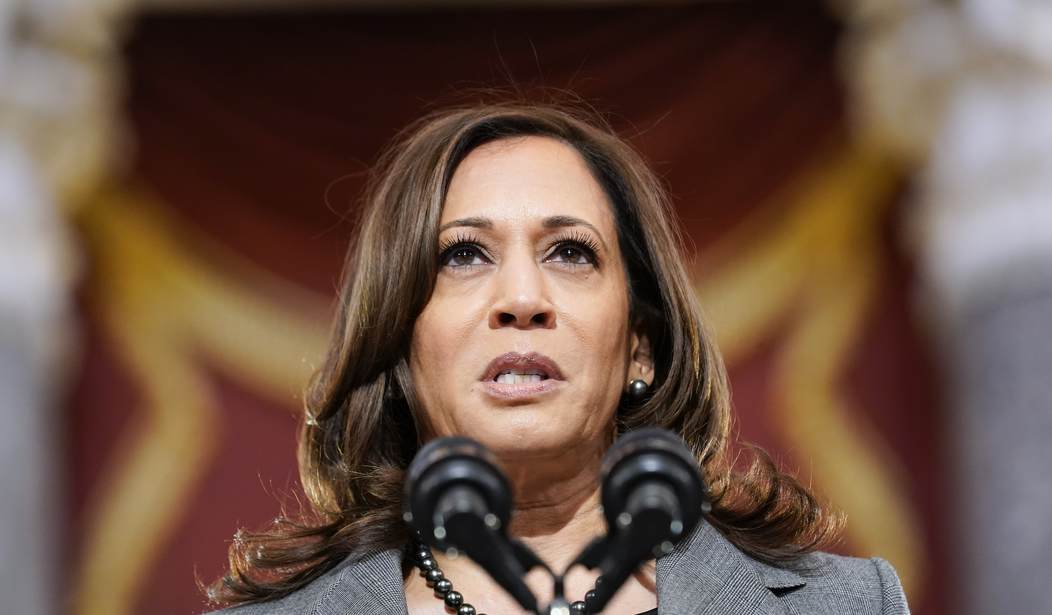Vice President Kamala Harris issued remarks on Tuesday, "Equal Pay Day," where she claimed that women working full-time make 83 cents for every $1 that a man makes. A fact sheet released Tuesday by the White House reiterated this claim. But is this accurate?
"Today, on average, working women, who are working full-time, year-round, make just 83 cents for every dollar that a man makes. And for many women of color, the gap is even wider. Over a 40 year career, a woman will lose out on about $400,000. For black women, Latina women, Native American women, that loss in wages is closer to $1 million," Harris said in her remarks to commemorate Equal Pay Day on Tuesday.
KAMALA: "Women who are working full time, year round, make just 83 cents for every dollar that a man makes...Over a 40 year career, a woman will lose out on about $400,000..." pic.twitter.com/2V9yKBhnka
— Townhall.com (@townhallcom) March 15, 2022
The statistic Harris cited in her claim was pulled from a report, "Bearing the Cost," released Tuesday by the Department of Labor. The report detailed how women were "disadvantaged" when it came to employment and pay during the COVID-19 pandemic.
The report states that "detailed data collection on the gender wage gap is not available for all groups in 2020 due to the impact of the pandemic on data collection" and that some of the gaps were filled in using data from 2019.
Back in September, the Department of Labor's Bureau of Labor Statistics unit (BLS) released a report, "Highlights of Women's Earnings in 2020," that stated "women who were full-time wage and salary workers had median usual weekly earnings that were 82 percent of those of male full-time wage and salary workers" in 2020.
Recommended
However, the American Enterprise (AEI) Institute published a response to the BLS' findings released in September regarding this reported gender wage gap between men and women. AEI Senior Fellow Mark Perry explained how the "gender earnings gap" in the BLS annual report can be explained by age, marital status, children, hours worked, and several other factors.
"Among full-time workers (those working 35 hours or more per week), men were more likely than women to work a greater number of hours. For example, 19.6% of men working full-time worked 41 or more hours per week in 2020, compared to only 10.2 percent of women who worked those hours, meaning that men working full time last year were nearly twice as likely as women to work 41 hours per work or more."
Perry added that men working full-time hours (4.3 percent) were 2.3 times more likely than women (1.9 percent) to work over 60 hours per week. Women were also more likely to work shorter workweeks of 35 to 39 hours per week. Perry noted that 7.7 percent of women worked those hours, while 3.6 percent of men did the same.
"What's especially interesting is that men working 35-39 hours per week last year earned only 92.4% of what women earned working those same hours ($600 median weekly earnings for men vs. $649 for women), i.e., there was a 7.6% gender earnings gap in favor of female workers for that cohort," Perry stated in the piece.
A separate analysis published in 2021 by Rachel Greszler, a research fellow in economics, budget and entitlements at The Heritage Foundation, explained how "activists have used the so-called pay gap between men and women as a call to legislative action—for policymakers to enact laws that will result in more closely aligned earnings between men and women."
"The problem with making policy based on the pay gap is that it provides an apples-to-oranges comparison that does not take into account all the things that can affect individuals' earnings, such as education, experience, hours, occupation, career interruptions, and benefits," the report added. In her summary, she noted that the so-called "wage gap" between men and women is "misleading and fails to account for the values that women and men place on the life choices they make. After accounting for measurable differences in labor market outcomes, and considering more difficult-to-measure preferences, the wage gap nearly disappears."
On Tuesday, Patrice Onwuka, director of the Center for Economic Opportunity at Independent Women's Forum, released a statement regarding the "misleading" statistic thrown around that women earn 83 cents for every dollar a man makes.
"This Equal Pay Day, let's start with an accurate picture of women's pay rather than a distorted view based on the misleading statistic that suggests that women earn 83 cents on the dollar compared to men. The real pay gap is just a few cents when various factors and choices women and men make in the labor force are taken into account. Yet, left-leaning activists and lawmakers use this data point to falsely claim that there is widespread sex-based discrimination," her statement said.
"They argue that Congress must fix the pay gap with federal legislation such as the so-called Paycheck Fairness Act. Sex-based discrimination is already illegal, new legislation is unnecessary at best and could backfire on women at worst," she concluded.
So while liberal lawmakers, celebrities, and the like push the narrative that women are paid less than men, supposedly because of their gender, critics have debunked these statistics to show that it's an inaccurate, polarizing, misleading figure rather than, as IWF puts it, "a metric of equal pay for equal work."
























